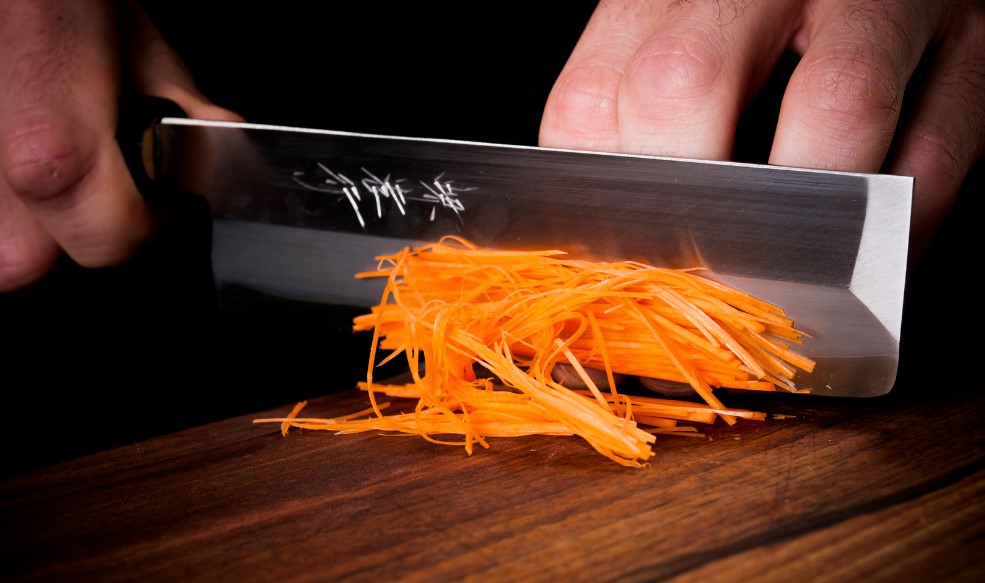If you’re someone who loves cooking with vegetables, you know that having the right tools can make all the difference in the kitchen. That’s where the Nakiri knife comes in – a Japanese-style vegetable knife that’s specifically designed for precision and efficiency. With its straight blade and squared-off tip, the Nakiri knife is the ultimate tool for slicing, chopping, and dicing vegetables with ease.
Table of Contents
But with so many options on the market, it can be overwhelming to choose the right Nakiri knife for your needs. That’s why we’ve created this guide to help you navigate the world of Nakiri knives. Whether you’re a seasoned chef or just starting out, this guide will provide you with all the information you need to select and use the perfect Nakiri knife for your kitchen. From the anatomy of a Nakiri knife to tips for maintenance and care, this guide will give you the confidence you need to elevate your vegetable game and take your cooking to the next level.
The Origins and Evolution of the Nakiri Knife
The Nakiri knife is a Japanese-style vegetable knife that has gained popularity in recent years among chefs and home cooks alike. The name “Nakiri” translates to “vegetable cutter” or “leaf cutter,” and it is designed to slice and chop vegetables with precision and ease.
The origins of the Nakiri knife can be traced back to Japan’s Edo period (1603-1868), where it was used by professional chefs in restaurants and homes. At the time, vegetables were a staple food in Japan, and the Nakiri knife was designed specifically to meet the needs of Japanese cuisine.

The Nakiri knife was traditionally made from carbon steel, which provided a sharp edge and allowed for easy sharpening. However, over time, stainless steel has become a more popular material due to its resistance to rust and staining. The blade of the Nakiri knife is typically thin and rectangular, with a straight edge that runs from the tip to the heel. The blade’s flat edge allows for precise cutting and chopping of vegetables, making it an essential tool in any kitchen.
Over the years, the Nakiri knife has evolved to include different variations, such as the Usuba, which is a single-beveled version of the Nakiri, and the Santoku, which is a Japanese general-purpose knife that combines the features of the Nakiri and the Gyuto (a Japanese-style chef’s knife).
Today, the Nakiri knife is widely recognized for its versatility and ease of use, and it is a popular choice among chefs and home cooks who prioritize vegetable preparation. Its unique design and sharp edge make it an essential tool for slicing, dicing, and chopping vegetables with precision and ease.
The Anatomy of a Nakiri Knife
The Nakiri knife boasts a double-beveled blade, allowing for precise and effortless cuts. Its thin, flat profile ensures a clean slice, while the square tip prevents accidental piercing of delicate vegetables. The blade length typically ranges from 5 to 7 inches, providing ample cutting surface for various tasks. The knife’s handle is designed to provide comfort and control during extended use.

The Nakiri knife is a Japanese-style vegetable knife that has a distinct anatomy designed to facilitate precise and efficient vegetable cutting.
Blade: The blade of the Nakiri knife is typically rectangular, with a straight edge that runs from the tip to the heel. The blade is usually made from either carbon steel or stainless steel, with a sharp edge that is easy to sharpen.
Spine: The spine of the Nakiri knife is thick and straight, providing stability and balance to the blade. It also allows the user to apply force when needed, without risking injury to the hand.
Tip: The tip of the Nakiri knife is typically squared off, which allows for precise cuts and reduces the risk of accidental piercing.
Edge: The edge of the Nakiri knife is straight and double-beveled, which allows for clean and efficient cutting through vegetables.
Heel: The heel of the Nakiri knife is wider and thicker than the rest of the blade, providing additional weight and balance to the knife. This design also allows for efficient chopping of vegetables and prevents the knife from slipping out of the user’s hand.
Handle: The handle of the Nakiri knife is typically made from wood or synthetic materials and is designed to provide a comfortable grip for the user. The handle may be traditional Japanese style, with a round shape, or Western style, with a more ergonomic grip.
The anatomy of the Nakiri knife is specifically designed to facilitate efficient and precise vegetable cutting. The straight blade, squared-off tip, and thick spine and heel all contribute to making the Nakiri knife a versatile and essential tool in any kitchen.
Why Every Kitchen Needs a Nakiri Knife
The Nakiri knife is ideal for a wide range of vegetable preparation tasks, including slicing, dicing, and chopping. Its versatile nature makes it an indispensable addition to your kitchen arsenal. Here are some reasons why the Nakiri knife should be a staple in every kitchen:
- Precision Cutting: The Nakiri knife’s sharp, thin blade allows for precise cuts, ensuring uniform slices of vegetables for presentation and even cooking.
- Effortless Slicing: The flat profile of the blade ensures that the entire length of the edge comes into contact with the cutting board, allowing for a smooth, even slice with minimal resistance.
- Versatility: While the Nakiri knife is specifically designed for vegetable preparation, it can also be used for other tasks, such as slicing fruits, herbs, and even some types of soft proteins.
- Ease of Use: The comfortable handle and balanced design of the Nakiri knife make it easy to use for both professional chefs and home cooks.
Mastering the Nakiri Knife: Techniques and Tips
To fully appreciate the benefits of a Nakiri knife, it’s essential to learn the proper techniques for using this specialized tool. Here are some tips to help you make the most of your Nakiri knife:
- The Claw Grip: When cutting with a Nakiri knife, adopt a claw grip by tucking your fingers under and resting the knuckles of your non-dominant hand against the flat side of the blade. This provides stability and control while keeping your fingers safe from the sharp edge.
- Push-Cut Technique: Instead of rocking the blade back and forth, use a push-cut technique by moving the knife in a straight, downward motion. This ensures a clean, even cut without crushing the vegetable.
- Maintaining the Edge: To preserve the sharpness of your Nakiri knife, hone it regularly with a honing rod and sharpen it with a whetstone as needed.
Who Makes The Best Nakiri Knives ?
There are several manufacturers that produce high-quality Nakiri knives, each with its own unique features and benefits. Here are a few examples of brands that are well-known for making excellent Nakiri knives:
- Shun: Shun is a popular Japanese knife brand that produces high-quality, handcrafted Nakiri knives with a traditional Japanese design. Shun Nakiri knives are made from premium VG-MAX steel and feature a durable and comfortable handle.
- Miyabi: Miyabi is another Japanese knife brand that produces high-quality Nakiri knives with a focus on precision and elegance. Miyabi Nakiri knives feature a unique and beautiful Damascus blade and a comfortable and ergonomic handle.
- Global: Global is a popular Japanese knife brand that produces high-quality, lightweight Nakiri knives with a unique, one-piece design. Global Nakiri knives are made from premium stainless steel and feature a comfortable and slip-resistant handle.
- Wüsthof: Wüsthof is a German knife brand that produces high-quality Nakiri knives with a focus on durability and sharpness. Wüsthof Nakiri knives are made from premium German steel and feature a comfortable and ergonomic handle.
Ultimately, the best Nakiri knife for you will depend on your personal preferences, budget, and intended use. It’s important to research different brands and read reviews from other users to find a Nakiri knife that meets your needs and expectations.
Choosing the Perfect Nakiri Knife for Your Kitchen
Selecting the ideal Nakiri knife for your needs involves considering several factors, such as:
- Blade Material: High-quality Nakiri knives are typically made from carbon steel, stainless steel, or a combination of the two. Carbon steel is known for its sharpness and edge retention but requires more maintenance to prevent rust. Stainless steel is more resistant to corrosion but may not hold an edge as well. Choosing the right material depends on your personal preferences and maintenance habits.
- Handle Material and Design: Nakiri knives come with a variety of handle materials, including wood, plastic, and metal. Consider your comfort and grip preferences when selecting a handle. Additionally, choose a handle design that offers ergonomic support and balance.
- Blade Length: Nakiri knives typically range from 5 to 7 inches in length. Consider the size of the vegetables you frequently prepare and your comfort level when selecting a blade length.
- Budget: Nakiri knives are available at various price points. While investing in a high-quality knife can be beneficial, consider your budget and how often you plan to use the knife before making a decision.

Caring for Your Nakiri Knife
Proper maintenance of your Nakiri knife is essential to ensure its longevity and performance. Follow these care tips to keep your knife in optimal condition:
- Cleaning: Always hand wash your Nakiri knife with warm, soapy water and dry it immediately after use. Avoid using abrasive materials that can scratch or dull the blade.
- Storage: Store your Nakiri knife in a knife block, magnetic strip, or protective sheath to prevent damage to the blade and ensure safety.
- Sharpening: Regularly hone your Nakiri knife with a honing rod to maintain its edge. When necessary, use a whetstone to sharpen the blade, following the manufacturer’s instructions.

Do I Need a Nakiri Knife ?
Whether or not you need a Nakiri knife depends on your personal preferences and cooking habits. Here are a few factors to consider when deciding if a Nakiri knife is right for you:
- Vegetable Preparation: If you frequently prepare vegetables in your cooking, then a Nakiri knife may be a useful addition to your kitchen. The straight blade and squared-off tip make it easy to chop and slice vegetables with precision and efficiency.
- Cooking Style: If you enjoy cooking Japanese cuisine or other dishes that feature a lot of vegetable-based dishes, then a Nakiri knife may be a valuable tool to have. Its design is well-suited for the precision and control needed for Japanese cooking.
- Knife Collection: If you are a knife enthusiast or collector, then adding a Nakiri knife to your collection may be appealing. It can be a beautiful and functional addition to your kitchen tools.
Ultimately, whether or not you need a Nakiri knife depends on your personal cooking habits and preferences. If you value efficient and precise vegetable preparation and enjoy using high-quality knives in your cooking, then a Nakiri knife may be a useful tool to have in your collection.
The Nakiri knife is an indispensable tool for any kitchen, providing precision, versatility, and ease of use when preparing vegetables. By selecting the right knife, mastering proper techniques, and maintaining your tool, you can enjoy the many benefits of this traditional Japanese knife.






